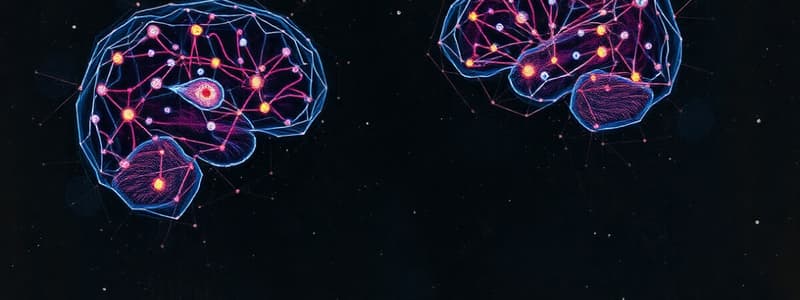Podcast
Questions and Answers
What is meant by calling the brain a 'deterministic machine'?
What is meant by calling the brain a 'deterministic machine'?
- It operates independently of external stimuli.
- It follows random processes in decision-making.
- It can predict every outcome accurately.
- Its functions can be precisely determined by its structure. (correct)
What does the term 'Optimal Codes' refer to in the context of the neural code?
What does the term 'Optimal Codes' refer to in the context of the neural code?
- Patterns of brain activity that have no variation.
- The least effective means of representing data.
- Analog signals used instead of digital signals.
- The most efficient way to transmit information with minimal noise. (correct)
Which of the following describes the Default Mode Network (DMN)?
Which of the following describes the Default Mode Network (DMN)?
- It mainly regulates motor functions.
- It is activated during goal-directed tasks.
- It is responsible for processing sensory information.
- It is involved in self-referential thought and mind-wandering. (correct)
What characterizes Cortical Oscillations in the brain?
What characterizes Cortical Oscillations in the brain?
What does the Bayesian Model imply about brain function?
What does the Bayesian Model imply about brain function?
What is a characteristic of the brain's coding mechanism?
What is a characteristic of the brain's coding mechanism?
Which of the following best describes the Default Mode Network (DMN)?
Which of the following best describes the Default Mode Network (DMN)?
What is meant by the term 'brain's dark energy'?
What is meant by the term 'brain's dark energy'?
What is a defining feature of cortical oscillations?
What is a defining feature of cortical oscillations?
Which approach is associated with how the brain processes information according to uncertainty?
Which approach is associated with how the brain processes information according to uncertainty?
What role do neurotransmitter receptor communities play in the brain?
What role do neurotransmitter receptor communities play in the brain?
What is a primary focus of neuroeconomics?
What is a primary focus of neuroeconomics?
How is the brain typically described in the context of its functions?
How is the brain typically described in the context of its functions?
What does the term 'flexible brain code' suggest?
What does the term 'flexible brain code' suggest?
What does the structure of the Triple Network Model emphasize?
What does the structure of the Triple Network Model emphasize?
Flashcards are hidden until you start studying
Study Notes
Introduction to the Brain
- The brain is considered a deterministic machine, meaning its actions are predictable based on its internal workings
- It's a complex organ responsible for thought, emotion & behavior
Neuroeconomics
- This field examines the relationship between brain activity, decision making, and economic outcomes
- Uses techniques like fMRI and EEG to understand brain responses during economic tasks
- Incorporates Bayesian approaches
Bayesian Approaches in Neuroscience
- Implement a probabilistic framework to model how the brain makes decisions and inferences.
- Accounts for uncertainty in sensory input & prior knowledge.
The Neural Code
- Deals with how the brain represents information through patterns of neuronal activity
- Optimal codes minimize redundancy and maximize information transmission
- Brain codes can be flexible and adapt to different contexts
- These codes often appear "noisy", meaning they have variability even in response to the same stimulus
- This may reflect inherent biological variability and complex processing
The Brain is Solving a Problem
- Aims to represent the external world and make predictions about future events
- Uses Bayesian inference to weigh sensory input and prior knowledge to make decisions
Brain's Dark Energy
- Refers to the brain's always-active, baseline processing
- This activity provides a baseline for cognitive function
JPEG Compression in the Brain
- Brain uses a similar compression method to JPEG images, simplifying information while preserving key features
- Reduces computational demands while preserving relevant information
The Default Mode Network (DMN)
- A large-scale brain network active during rest and introspection
- Involved in self-referential processing, internal thought, and memory
- Often shows decreased activity during tasks requiring external attention
- Interacts with other networks like the dorsal attention network and salience network
- Contributes to understanding the relationship between different mental states
Triple Network Model
- Proposes three main brain networks: the DMN, the dorsal attention network, and the salience network.
- Each network plays a role in directing attention, regulating behavior and integrating information
- The interaction of these networks is vital for flexible cognitive control
Cerebral Cortical Oscillations
- The rhythmic patterns of electrical activity within the cerebral cortex
- Categorized by their frequency ranges, with each range associated with specific cognitive functions
- These oscillations are nested, meaning they can be present at different frequencies simultaneously
Alpha Oscillations
- Have a frequency range between 8-12 Hertz (Hz)
- Often associated with relaxed, awake states and visual processing
Laminar Distribution of Frequencies
- Different neuronal layers in the cerebral cortex exhibit different dominant frequency ranges.
- This indicates the specialization of different layers for specific brain functions.
The Brain as an Ecosystem
- Highlights the complex interplay of different cell types, neurotransmitters, and networks.
- Emphasize the interconnectedness of the brain's components for proper function.
Introduction
- The brain is a complex organ that processes information and controls bodily functions.
- Described as a "deterministic machine" - meaning its actions are predictable based on its structure and processes.
Neuroeconomics
- Blends principles of neuroscience, economics, and psychology to study decision-making under uncertainty.
- Uses Bayesian approaches, which involve updating beliefs based on new evidence.
The Neural Code
- Refers to how neurons represent information.
- Optimal codes are efficient and minimize errors.
- Brain codes are flexible and can adapt to different circumstances.
- Optimal codes can appear noisy, but this noise can be informative.
- Brain codes are complex and involve multiple levels of processing.
Problem the Brain is Solving
- The brain constantly receives information from the environment and must make sense of it.
- It needs to infer the underlying causes of sensory input, even when information is incomplete or ambiguous.
- The brain uses Bayesian models to make inferences, combining prior knowledge with new evidence.
Brain's Large-scale Networks
- Refers to the interconnected regions of the brain that work together to perform complex functions.
- Considers the brain as an ecosystem with different parts that operate synergistically, influenced by neuronal activity, brain rhythms, and neurochemicals.
- The brain exhibits “Dark Energy," which is the energy that drives the brain's activity.
- The term refers to the complex, poorly understood interactions between neurons, brain regions, and their activity levels.
- The brain's activity can be compared to JPEG image compression.
- It uses efficient coding strategies to reduce the amount of information that needs to be processed, similar to how algorithms work for compressing images.
Default Mode Network (DMN)
- Sits in the forefront of consciousness
- Involved in self-reflection, memory, planning, and social cognition.
- Shows reduced activity during goal-directed tasks.
- The DMN is complex and contains multiple interconnected brain regions, highlighting the complexity of brain activity.
- Shows high correlation with internal states or mental operations.
- Activated during passive states and mind wandering
Triple Network Model
- Proposes that the DMN interacts with two other large-scale networks:
- The salience network - identifies important stimuli and directs attention.
- The task-positive network - responsible for goal-directed behavior and cognitive control.
Cerebral Cortical Oscillations
- Rhythmic electrical activity in the brain's cortex.
- Different frequencies of oscillations are associated with different cognitive states.
- Cortical oscillations are nested within each other, contributing to the complexity of brain activity and communication between brain regions.
Alpha Oscillations
- Occur in the range of 8-12 Hz.
- Often associated with relaxation and a state of wakeful rest.
- Can be suppressed during cognitive tasks and increased during meditation
Laminar Distribution of Frequencies in the Primate Cerebral Cortex
- Different frequencies are associated with different layers of the cerebral cortex.
- This suggests that the brain uses frequency-specific communication to process information.
Neurotransmitter Receptor Communities
- Brain is dynamic and constantly adapting to new information and experiences.
- This complexity highlights the need for understanding how different brain regions communicate and integrate information.
- Represents an emerging area of research that explores the influence of neurochemicals and signaling pathways on brain function and behavior.
Studying That Suits You
Use AI to generate personalized quizzes and flashcards to suit your learning preferences.




